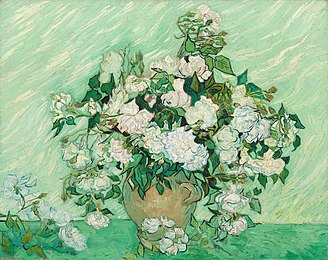Impasto

Impastois a technique used inpainting,wherepaintis laid on an area of the surface thickly,[1]usually thick enough that thebrushorpainting-knifestrokes are visible. Paint can also be mixed right on the canvas. When dry, impasto provides texture; the paint appears to be coming out of the canvas.
Etymology
[edit]The wordimpastois Italian in origin; in which it means "dough" or "mixture"; related to the verbimpastare,"to knead", or "to paste". Italian usage ofimpastoincludes both a painting and apotting technique.The root noun ofimpastoispasta,meaning "paste".[2]
Media
[edit]Oil paintis the traditional medium for impasto painting, due to its thick consistency and slow drying time.Acrylic paintcan also be used for impasto by adding heavy body acrylic gels. Impasto is generally not used inwatercolorortemperawithout the addition of thickening agent due to the inherent thinness of these media. An artist working inpastelscan produce a limited impasto effect by pressing a soft pastel firmly against the paper.
Purposes
[edit]The impasto technique serves several purposes. First, it makes the lightreflectin a particular way, giving the artist additional control over the play of light in the painting. Second, it can add expressiveness to the painting, with the viewer being able to notice the strength and speed by which the artist applied the paint. Third, impasto can push a piece from a painting to a three-dimensional sculptural rendering. The first objective was originally sought by masters such asRembrandt,Titian,andVermeer,to represent folds in clothes or jewels: it was then juxtaposed with a more delicate painting style. Much later, the FrenchImpressionistscreated pieces covering entire canvases with rich impasto textures.Vincent van Goghused it frequently for aesthetics and expression.Abstract expressionistssuch asHans HofmannandWillem de Kooningalso made extensive use of it, motivated in part by a desire to create paintings which dramatically record the action of painting itself. Still more recently,Frank Auerbachhas used such heavy impasto that some of his paintings become nearly three-dimensional.
Impasto gives texture to the painting, meaning it can be opposed to moreflat,smooth, or blended painting styles.
Artists
[edit]Many artists have used the impasto technique. Some of the more notable ones including:Rembrandt van Rijn,Diego Velázquez,Vincent van Gogh,Jackson Pollock,andWillem de Kooning.
- Selected examples of paintings which make use of the impasto technique
-
Crags and CrevicesbyJane Frank(1960). As with manyabstract expressionistworks (and many so-called "action paintings"as well), impasto is a prominent feature.
-
Taos Mountain, Trail HomebyCordelia Wilson(1920). A landscape entirely executed with a bold impasto technique.
-
Starry Nightby van Gogh (1889). The impasto technique and line structure gives his viewers the feeling that the sky is moving.[3]
-
Self PortraitbyRembrandt(1660). His use of impasto was surely inspired byTitian,and the addition of impasto showed a new method of illusion in the artist's work.[4]
See also
[edit]References
[edit]- ^Impasto.In:Weyer, Angela; Roig Picazo, Pilar; Pop, Daniel; Cassar, JoAnn; Özköse, Aysun; Jean-Marc, Vallet; Srša, Ivan (Ed.) (2015). Weyer, Angela; Roig Picazo, Pilar; Pop, Daniel; Cassar, JoAnn; Özköse, Aysun; Vallet, Jean-Marc; Srša, Ivan (eds.).EwaGlos. European Illustrated Glossary Of Conservation Terms For Wall Paintings And Architectural Surfaces. English Definitions with translations into Bulgarian, Croatian, French, German, Hungarian, Italian, Polish, Romanian, Spanish and Turkish.Petersberg: Michael Imhof. p. 100.doi:10.5165/hawk-hhg/233.Archived fromthe originalon 2020-11-25.Retrieved2016-02-09.
- ^Webster's New World dictionary of the American language.Guralnik, David B. (David Bernard), 1920-2000. (New rev., expanded pocket-size ed.). New York, N.Y.: Warner Books. 1982.ISBN0446311928.OCLC10638582.
{{cite book}}:CS1 maint: others (link) - ^Naifeh, Steven, 1952- (2011).Van Gogh: the life.Smith, Gregory White. (1st ed.). New York: Random House.ISBN9781588360472.OCLC763401387.
{{cite book}}:CS1 maint: multiple names: authors list (link) CS1 maint: numeric names: authors list (link) - ^Walter Liedtke, Carolyn Logan, Nadine M. Orenstein, Stephanie S. Dickey, “Rubens and Rembrandt: A Comparison of Their Techniques,”Rembrandt/not Rembrandt in the Metropolitan Museum of Art,New York: Metropolitan Museum of Art, 1995.
External links
[edit] Media related toImpasto (painting)at Wikimedia Commons
Media related toImpasto (painting)at Wikimedia Commons- Lindberg, Ted.Alfred Currier: Impasto
- National Portrait Gallery, London.Impasto
- Tate Britain Gallery, London. Frank Auerbach, Bacchus & Ariadne.
- How to thin acrylic paintEasy Achieve Beautiful.
- Acrylic ImpastoAcrylic Impasto Techniques by Anastasia Trusova



![Starry Night by van Gogh (1889). The impasto technique and line structure gives his viewers the feeling that the sky is moving.[3]](https://upload.wikimedia.org/wikipedia/commons/thumb/e/e8/Van_Gogh_-_Starry_Night_-_Google_Art_Project-x0-y0.jpg/300px-Van_Gogh_-_Starry_Night_-_Google_Art_Project-x0-y0.jpg)
![Self Portrait by Rembrandt (1660). His use of impasto was surely inspired by Titian, and the addition of impasto showed a new method of illusion in the artist's work.[4]](https://upload.wikimedia.org/wikipedia/commons/thumb/2/2d/Rembrandt_-_Self-portrait%2C_1660.JPG/256px-Rembrandt_-_Self-portrait%2C_1660.JPG)